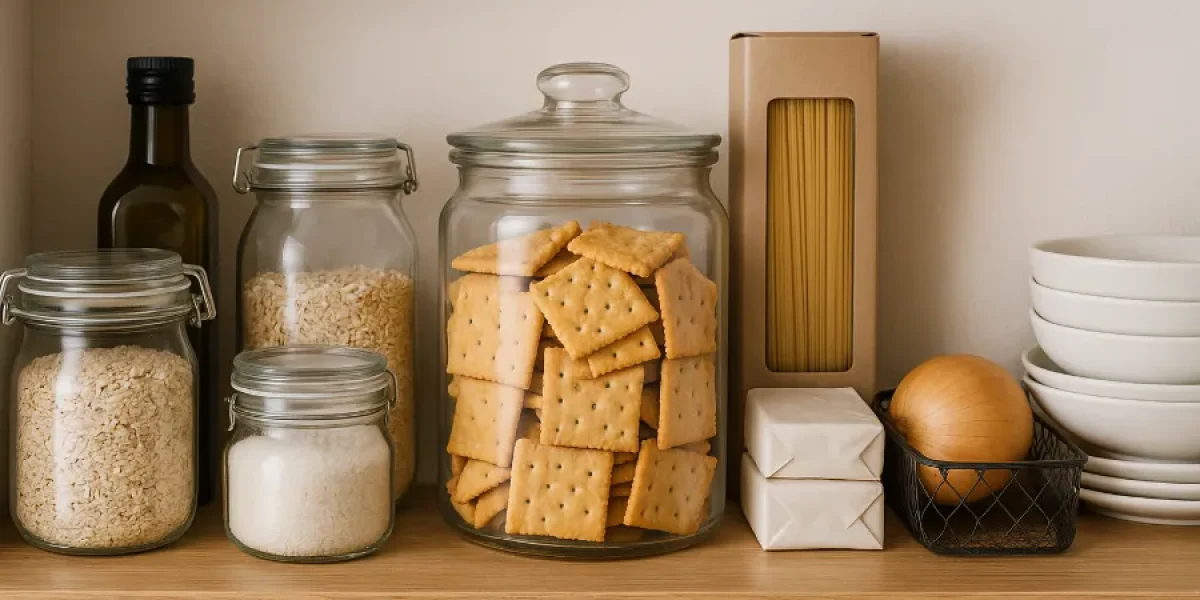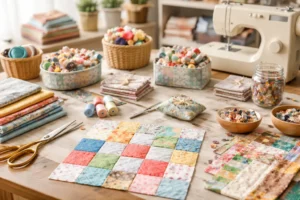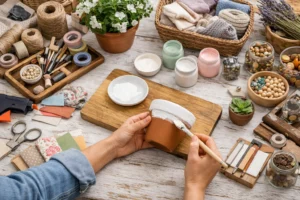There’s a certain magic in pulling a tray of homemade crackers from the oven — the golden color, the toasted aroma, and that perfect snap when you break one in half. But keeping that crunch? That’s where things get tricky. The biggest question home bakers ask (and the one I’ve wrestled with myself) is how to store homemade crackers so they stay crisp, flavorful, and fresh for more than a day or two.
Whether you’re baking buttery rosemary crisps or rustic seeded flatbreads, mastering storage is just as important as perfecting the dough. In this post, I’ll walk you through the best way to keep homemade crackers crunchy, share restaurant-level storage techniques, and revisit some old-fashioned, time-tested methods that our grandmothers swore by.
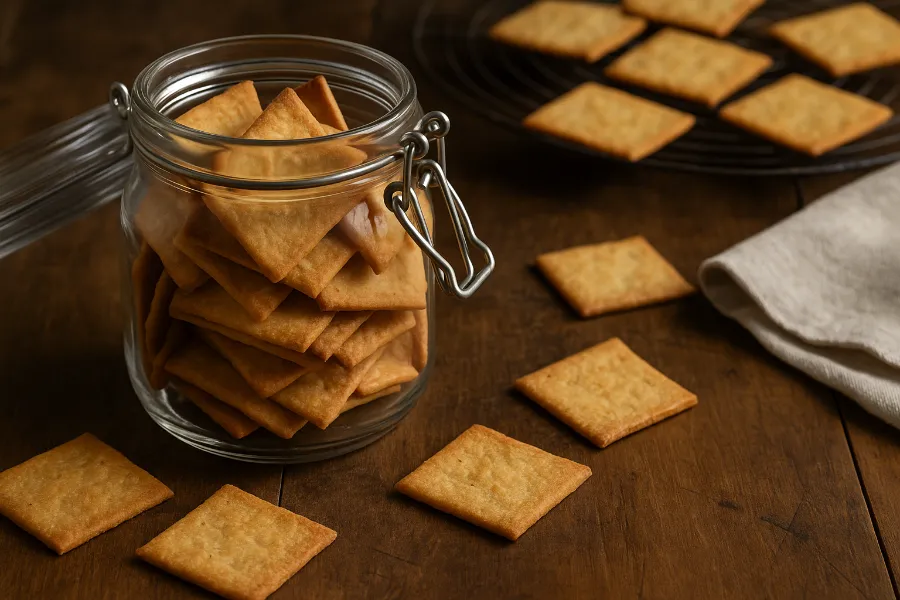
How to Store Homemade Crackers (and Why It Matters)
If you’ve ever baked a perfect batch only to find them soft the next morning, you’ve met the silent enemy of crunch: moisture. Crackers are intentionally baked dry, but the air in your kitchen isn’t. As soon as they cool, they start absorbing humidity from the environment, especially if you live somewhere warm or coastal. Even a little moisture turns that crisp snap into a soft chew.
That’s why learning how to store homemade crackers is about more than keeping them in a cute jar — it’s about controlling air, temperature, and humidity. The right method can mean the difference between a perfectly crisp bite and a disappointing, stale one. Let’s break it down step by step — starting right after you pull them out of the oven.
Best Way to Keep Homemade Crackers Crunchy
Here’s something I learned the hard way: the real work of keeping crackers crunchy doesn’t start with the container — it starts with the cooling. Even after baking, crackers hold a little steam inside. If you rush them into a jar while they’re still warm, that steam turns into condensation, and condensation equals sogginess.
My go-to method for crunchy success:
- Leave crackers on the baking sheet for a few minutes after removing from the oven.
- Transfer them to a wire rack so air can circulate underneath.
- Let them cool completely — I mean completely dry to the touch.
- If it’s humid out, pop them back into the oven for 5 minutes at 200°F (93°C).
That last step — a low-heat “drying session” — is how professional bakers extend shelf life. It removes those last few drops of moisture hiding in the dough.
Once you’ve cooled them properly, it’s time to think about where they’ll live.
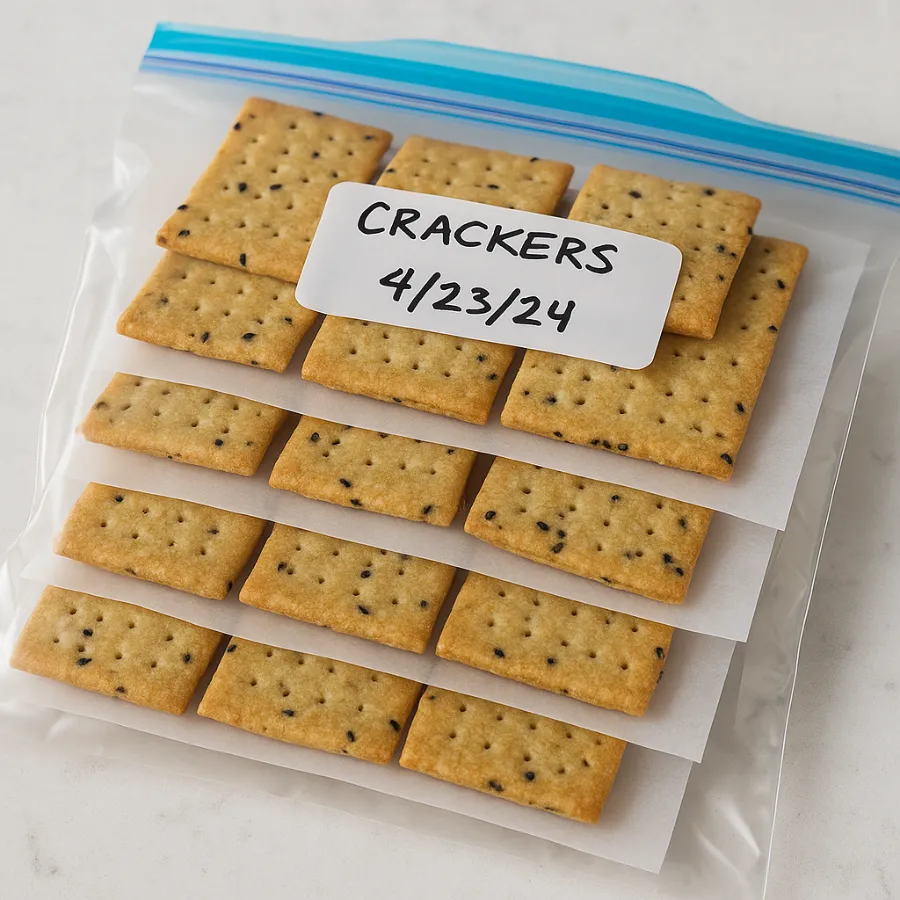
How to Keep Crackers from Going Stale
Even the crispiest batch can lose its edge over time. The main culprit? Air exposure. Every time crackers meet humidity, they absorb it — and slowly go stale.
Here’s how to fight back:
- Seal them tight. Choose containers designed to lock out air.
- Avoid temperature swings. Heat encourages moisture transfer.
- Store in small batches. Opening one giant container repeatedly lets in air each time.
If you accidentally leave them out overnight (we’ve all done it), you can revive them. Just bake at 300°F (150°C) for about 5–8 minutes, then let them cool on a rack. They’ll crisp up beautifully again.
It’s one of those “baker’s safety nets” I wish I’d learned sooner.
Airtight Kitchen Containers: Your Best Defense Against Soggy Crackers
Once your crackers are completely cool, airtight kitchen containers are your best friend. Forget fancy gadgets — this is all about sealing out humidity.
My Top Container Picks:
- Glass jars with rubber gaskets (like Mason jars): These create a reliable airtight seal and look charming on open shelves.
- Metal tins: Old-school biscuit tins are excellent at blocking light and moisture.
- Vacuum-seal bags: For long-term storage, nothing beats removing every bit of air.
- High-quality plastic containers with silicone seals: Convenient and durable for everyday snacking.
Avoid cardboard boxes and paper bags — they’re breathable, and “breathable” equals “stale.”
A pro tip I learned from a pastry chef friend: tuck a tiny food-safe silica gel packet or a sachet of uncooked rice (wrapped in cheesecloth) into the jar. It quietly absorbs humidity and extends the crunch life of your crackers by days.
Pantry Storage Ideas That Actually Work
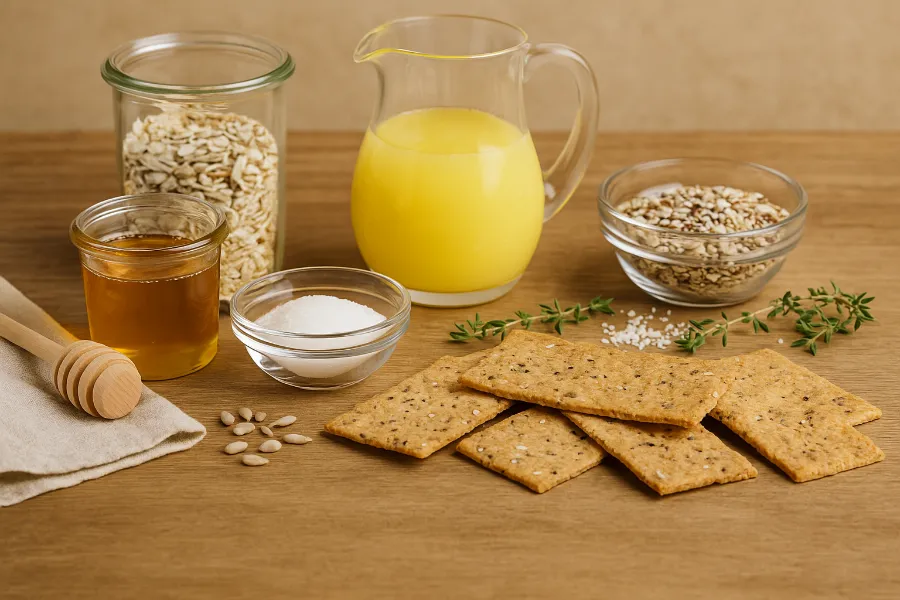
If you’re lucky enough to have a pantry, it can be your cracker’s best environment if you set it up right. Here’s how to turn your pantry into a cracker-friendly zone:
- Keep it cool and dry. Aim for 60–70°F (15–21°C).
- Avoid heat sources. Don’t store near ovens, dishwashers, or sunny windows.
- Separate your snacks. Strong-smelling foods (like onions or coffee) can transfer flavor to crackers.
- Add humidity absorbers. Even a jar of baking soda or a cloth bag of rice can help balance moisture.
If your region is humid year-round, consider refrigerating your sealed containers — but make sure to let them reach room temperature before opening. That way, condensation doesn’t form on the crackers themselves.
These small adjustments transform how long your crackers stay crunchy, no matter what the weather’s doing outside.
How Long Do Homemade Crackers Last?
The shelf life of homemade crackers depends on both the ingredients and how you store them. Here’s a simple guide you can trust:
| Storage Method | Shelf Life | Notes |
|---|---|---|
| Airtight at room temperature | 7–10 days | Ideal for most plain crackers |
| Refrigerated (airtight) | Up to 1 month | Keeps fats from going rancid |
| Frozen (vacuum-sealed) | 2–3 months | Re-crisp before serving |
Crackers with butter, cheese, or nuts tend to spoil faster because the fats oxidize over time. Simpler recipes made with just flour, oil, and salt tend to last longer.
If you ever smell something “off” or notice a greasy feel, it’s time to toss them — that’s usually the first sign of rancidity.
Restaurant Techniques: How Professionals Keep Crackers Fresh
When you work in a kitchen that serves crackers or crostini every night, you learn fast how to keep them fresh between batches. Here are a few professional tips that translate beautifully for home use:
- Bake low and slow for the final minutes. This gently drives out any lingering moisture without browning the crackers further.
- Cool in a dry space. Professional kitchens often use holding drawers or dehydrators that circulate warm, dry air.
- Store in portions. Instead of one large tin, use smaller containers so you only open what you need.
- Minimize oil content. A light brushing of oil adds flavor, but too much can absorb humidity and soften the texture.
- Add desiccants. Many restaurants drop a food-safe silica pack inside their tins — the same kind used in packaged chips or cookies.
I picked up these tricks while consulting a local bakery, and I still use them at home. They’ve saved me from countless stale-cracker disappointments.
Traditional Ways to Store Crackers (Before Airtight Containers Existed)
Long before we had vacuum sealers and desiccants, home cooks relied on simple but brilliant methods to keep their food dry.
1. Metal Tins and Linen Cloths
Crackers were often stored in biscuit tins lined with clean linen. The cloth absorbed oils and prevented moisture buildup — and the tin kept everything protected from air and light. It’s still one of my favorite old-fashioned tricks.
2. Rice or Salt Sachets
A handful of uncooked rice or coarse salt wrapped in cheesecloth works wonders as a natural moisture absorber. It’s the ancestor of today’s silica packs — safe, reusable, and effective.
3. Earthen or Clay Jars
Unglazed clay jars were the original “airtight” containers. They offered subtle airflow to prevent condensation without letting humidity seep in.
4. Re-baking Weekly
In some coastal households, crackers were simply re-baked every few days. A short warm-up in the oven restored their crunch and prevented mold in humid environments.
Sometimes, the simplest ideas stand the test of time because they just work.
Hygienic and Safe Cracker Storage
Beyond crunch, storage should also protect your crackers from contamination.
Here’s how I keep mine safe and fresh without compromising texture:
- Wash and thoroughly dry containers before each use.
- Avoid touching crackers with damp or oily hands.
- Always cool completely before sealing.
- Label your jars with bake dates to track freshness.
If you plan to sell or gift your crackers, include a clear “best by” date. Homemade products don’t contain preservatives, so this extra transparency ensures everyone enjoys them at their peak.
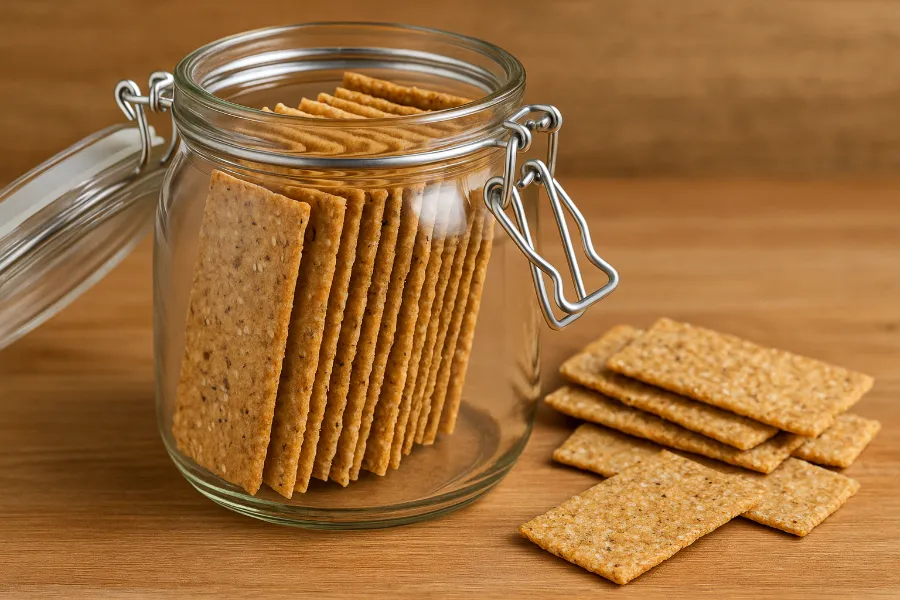
Can You Freeze Homemade Crackers?
Yes — and freezing can be a game-changer for busy bakers.
Here’s how to freeze them without losing crunch:
- Cool completely and layer between parchment paper.
- Place in a freezer-safe airtight bag or vacuum-seal pouch.
- Label with the date and freeze flat.
- When ready to serve, thaw uncovered at room temperature and re-crisp in a 300°F oven for 5 minutes.
This method is perfect for prepping ahead of holidays, picnics, or snack boxes. Your crackers will taste oven-fresh every time.
Ingredient Choices That Affect Freshness
The ingredients you use have a direct impact on how long your crackers stay crunchy.
Best Ingredients for Longer Shelf Life
- Low-moisture fats: Clarified butter or oil keeps texture stable.
- No dairy: Avoid milk or fresh cheese unless you’ll eat them quickly.
- Dry toppings: Seeds, herbs, or flaked salt add flavor without moisture.
- Light sugar content: A small amount of sugar or honey helps balance humidity.
And here’s a tip I learned from a pastry chef: bake at a slightly lower temperature for a few extra minutes. It creates a drier, more stable texture that resists staling.
My Favorite Pantry Routine for Crackers
Here’s what my personal pantry routine looks like now:
- I cool every batch completely on wire racks.
- I store them in labeled glass jars with parchment layers.
- Each jar holds a tiny rice sachet for humidity control.
- The jars live on the coolest, darkest pantry shelf — far from the oven.
- Once a week, I open them briefly to check freshness.
This little system means I can bake crackers on a lazy Sunday and still have them perfectly crisp by Friday’s cheese board night.
It’s not fancy — just consistent. And consistency, as with most baking, is the real secret ingredient.
Final Thoughts: Mastering Crunch That Lasts
Learning how to store homemade crackers has completely changed how I bake. Once you understand moisture, temperature, and air exposure, it becomes second nature to protect that perfect crunch. Use airtight kitchen containers, lean on simple pantry storage ideas, and don’t be afraid to borrow a few restaurant techniques. Most importantly, treat the cooling phase as seriously as the baking itself.
Crackers might be small, but when you get them right — crisp, clean, and flavorful — they’re proof that great baking is all about the details. Because when you’ve put love into baking them from scratch, they deserve to stay perfect from the first bite to the last crumb.
FAQs
Let crackers cool completely before sealing them in airtight containers. Keep them in a cool, dry place away from humidity and heat sources.
Store crackers in small airtight kitchen containers to reduce air exposure. You can also add a food-safe silica pack or rice sachet to absorb moisture.
Glass jars with rubber seals, metal tins, or vacuum-seal bags work best. Avoid paper or cardboard packaging, as they allow humidity to seep in.
Properly sealed crackers last 7–10 days at room temperature. Extend their life by refrigerating or freezing and re-crisping before serving.
Yes. Freeze completely cooled crackers in airtight bags or containers, then re-crisp in a low oven for 5 minutes before serving.
Store crackers in a cool, dark, and dry section of your pantry. Keep them away from ovens, dishwashers, and moisture-producing foods.
Moisture from the air softens the starches inside crackers. Cooling properly and using airtight containers prevents rehydration and keeps them crisp.

